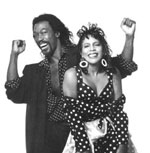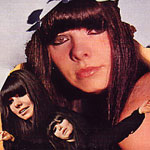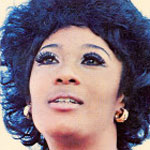
Sometimes you see a certain something in the strangest of circumstances. Let me give you an example. There I was browsing in the local branch of TK Maxx, shopping for clothes I really don’t need, when I chanced upon a Hope And Glory t-shirt with a selection of old soul 45s on the front, and right there most prominently was The Daisies’ Cold Wave, a northern favourite written by the famed Nick Ashford and Val Simpson, a song I have on one of the populist Talcum Soul sets. The retail industry’s appropriation of pop artefacts continues to disorientate. I turned on the radio the other day and the Strangeloves’ Night Time was being used to sell something or other. It’s odd.
The immortal Ashford & Simpson songwriting team entered the fray way back in New York with a mixed background of street and gospel. Early on they were among the staff writers at Scepter Wand where (with Joshie Jo Armstead initially) they set about creating a great American songbook, with creations for Maxine Brown, Candy and the Kisses, Ronnie Milsap, and more. Just think of songs like Wonder What My Baby’s Doing Tonight and Never Had It So Good. The success of Ray Charles’ cover of their Let’s Go Get Stoned brought the team to the attention of Berry Gordy out at Motown.
Ashford & Simpson wasn’t the only songwriting team to serve its apprenticeship at Scepter and other soul/r’n’b imprints of the mid-‘60s. The partnership of Lori Burton and Pam Sawyer too was working away at creating off-the-shelf classics for whatever outfit was to hand. And if there wasn’t one to hand then they’d just make one up. Their Whyte Boots ghost group’s classic girl gang outing Nightmare more than matched what Shadow Morton was doing with the Shangri-Las, and a subsequent set of their songs sung by Lori has now become a classic thanks to the salvage expertise of Rev-ola. The duo too moved to Motown but Lori couldn’t be bothered to stick around and play the songwriting game.

The songs Ashford & Simpson created at Motown are almost a history of the late twentieth century in miniature. If you just take Diana Ross’ early eponymous solo set, there you have Reach Out and Touch (Somebody’s Hand), You’re All I Need To Get By, Ain’t No Mountain High Enough. You get the picture. Having established themselves as great songwriters, the team struggled to convince the Motown hierarchy that they could be great producers too. They did. They produced some of the great Marvin Gaye and Tammi Terrell duets, like Your Precious Love and Ain’t Nothing Like The Real Thing, before Tammi’s tragic and untimely death.
And they were performers too, and so the story develops with Val recording two solo sets for Motown in the early ‘70s. While they may not have set the world on fire, they nevertheless have endured as classics. The occasionally spot-on Spectrum imprint salvaged both solo sets in 2004 and so they took on a new lease of life and acquired the, ahem, exposure warranted. The sets are chock-full of soul gems, and emanate from one of the genre’s more interesting periods when things were getting confused as the ‘60s turned in to the ‘70s, and things got more adventurous and maybe less dancefloor oriented. There’re great gospel roots showing through on these recordings, which show a strength and determination many of Val’s contemporaries were lacking at what was a difficult time for Motown’s ladies, wondering should they stay or should they go?
Meanwhile Lori had moved on, but Pam Sawyer stuck it out at Motown, getting her name on some important credits like the Supremes’ Love Child (and indeed rather later Diana’s Love Hangover). Among the new breed she worked with was Gloria Jones of Tainted Love infamy. Together their compositions would pop up in special places, a Gladys Knight gem here, Chris Clark’s Bad Seed there, through to the monumentally funky social commentaries The Assembly Line and The Zoo on the Commodores’ debut Machine Gun set. It’s no wonder Gloria struck up such a special relationship with Marc Bolan. Incidentally ex-pat east ender Pam Sawyer would also have a hand in writing songs (like The Day Will Come Between Sunday and Monday) for Kiki Dee, the first white Brit girl to record for Motown.

Probably the greatest Ashford & Simpson composition is California Soul, a classic that’s been covered by all sorts of folk, from Marvin & Tammi to Gerald Wilson to the 5th Dimension to Smokey Robinson. But the definitive version remains Marlena Shaw’s from her peerless Spice of Life set, which also spawned the amazing Woman of The Ghetto and Liberation Conversation, perennial favourites of funk/breaks cratediggers. The Spice of Life set was sprinkled with magic dust by the Chess/Cadet arranger Richard Evans, who was also behind Soulful Strings’ Burning Spear and Dorothy Ashby’s Afro Harping, as well as many others like some of Terry Callier’s greatest moments. California Soul would take on new life through the adaptations of hip hop’s leading lights like Gang Starr and DJ Shadow.
After Motown Ashford & Simpson would take on new life as a sophisticated
soul act that adapted easily to the advent of disco. In 1979 they
masterminded a Diana Ross renaissance with the gorgeously lush The Boss
set, from which No One Gets The Prize became a huge New York club favourite
(especially the Danny Krivit edit of the remix by Val’s brother
Jimmy). From the same era the song Bourgie Bourgie, which they
wrote for old Motown comrade Gladys Knight, was one of the disco classics
that inspired the folks up at Postcard Records so much. So much
so in fact the title was appropriated for an ill-fated group that evolved
from the Jazzateers with Paul Quinn on vocals.
Diana’s follow-up to The Boss would be produced by the Chic Organisation, another of the major Postcard influences. This set completed however temporarily the transformation of Diana, and contains some of Chic’s most enduring songs outside of Sister Sledge. Around the same time they recorded Spacer with Sheila and B Devotion which is about as good as pop gets and the song Orange Juice desperately aspired to.
Other Ashford & Simpson entries in the great American songbook include I’m Every Woman and their own hit/anthem Solid (from a set partly recorded at Blank Tapes, the New York studio more usually associated with Ze Records). Solid illogically is a song I endlessly confuse with Ashley & Jackson’s Solid Gold, a lost classic from the acid jazz era with A Certain Ratio connections if my memory hasn’t deserted me altogether.
© 2006 John Carney